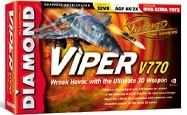| The Effects of 3d Vaporware
by John Reynolds |
||||
|
A veritable storm broke out across certain sections of the internet two weeks ago when Diamond released its newest video card, the Viper 770, to members of the online press for previewing. Based on nVidia's TnT2 chipset, the Viper 770 was a high-end board, clocked at 175mhz and sporting 6ns 200mhz memory modules. Expecting little more than a moderately faster version of the current TnT, the online gaming community was taken completely by surprise as the Viper measured up against and actually surpassed - according to all of the previews - the heretofore, largely undisputed barometer of 3D acceleration, 3dfx. The inevitable soon followed: the hardware news groups lit up like a Christmas tree as skirmish lines were formed; game websites offering purchase polls saw the former leader, 3dfx's Voodoo3, left in the dust as votes poured in for the TnT2; and shot and dart fell thick amongst brand-loyal combatants, leaving the battlefield littered with fractured facts, wounded misconceptions, and sanguine logic. And all of this over vaporware. . .it's enough to make you wonder. But before pursuing this discussion, I need to define my interpretation of the word vaporware. It's quite simple, really. Vaporware, hardware or software, is something that's not currently available on the market. You may read about it, see pictures of it, peruse detailed technical specifications in *.pdf files, even dream about it, but if you can't go to a local store or your favorite website and buy it then your attention is devoted to an ethereal beast rightfully called - yes, you guessed it - vaporware!
If you find yourself falling victim to this mercurial disease, please seek the aid of this editorial immediately. Or else email me, because I have some Floridian land up for grabs just for you
Now that we're on a level playing field, allow me to use one preview of the TnT2 as a shining example of the potential dangers of vaporware. Written by Tom Pabst, "nVidia Rocks the Boat with TnT2" is a bold piece of online journalism that trumpets nVidia's latest offering as the irrefutable, inviolable sovereign of 3D acceleration.
|

It's standard stuff, insofar as most online previews go, with Tom walking through a limited suite of benchmarks before arriving at concrete conclusions. But does anyone else consider it even slightly irresponsible for an as-then-unannounced product running on alpha drivers to be given such accolades as seen in the following quotation from Tom's article:
"NVIDIA has in any case got all reason and all rights to throw a huge party now. They've managed to push 3Dfx from the throne that 3Dfx occupied for over 3 years. The company that produces the fastest 3D-chip for PCs is from now on to be called NVIDIA. What have I read recently? "The King is dead, long live the King?" - I may be excused for altering that a bit to "The old King lies on his death bed, long live the new King from a different and more progressive tribe." Let's hope that the new king won't get as lazy as the old king did ..." Is Tom proclaiming a final verdict perhaps just a bit prematurely, or will the incarnation of the Viper 770 tested by Mr. Pabst arrive on the marketplace identical to, if not even faster than, the board hand-picked and delivered by company representatives? Goodness knows that all companies walk the straight and narrow, never overhyping their own products, never tweaking their drivers to falsify benchmark results, never embarking on bloated advertising campaigns aimed at the more illusory mainstream market while ignoring the desires of hardcore gamers. All sarcasm aside, my beef with Mr. Pabst's preview is not founded in brand-loyalty to any of nVidia's competitors, but rather in the fact that Tom employed an extremely limited test-bed upon which to construct his premature proclamations. Furthermore, allow me to inject that I am not suggesting that Tom falsified the results of his testing; instead, I am clearly asserting that Tom, as the above quote demonstrates, has irresponsibly served as a vehicle for the dissemination of misinformation. Go to Page Two |
|||
|
Copyright © 1997 - 2000 COMBATSIM.COM, INC. All Rights Reserved.
Last Updated March 29th, 1999 |
||||

